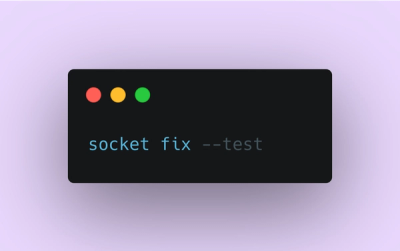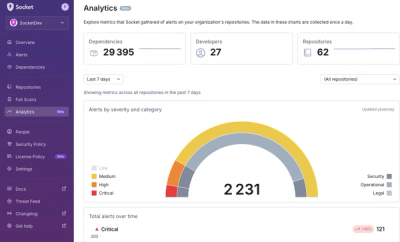
Product
Introducing Socket Fix for Safe, Automated Dependency Upgrades
Automatically fix and test dependency updates with socket fix—a new CLI tool that turns CVE alerts into safe, automated upgrades.
Tools for packaging and publishing to pypi for those who just don not want to deal with it
Tools for packaging and publishing to pypi for those who just don't want to deal with it
To install (for example):
pip install wads
We're going to assume you pointed "pack" to "wads/pack.py" and "populate" to "wads/populate.py",
because it's convenient for us to do so. You can achieve this in various ways
(for example, putting the contents:
python /Users/Thor.Whalen/Dropbox/dev/p3/proj/i/wads/wads/pack.py "$@"
in a file named "pack" contained in your OS's script path.)
When? When you got a new project and you want to quickly set it up with the packaging goodies.
Basic usage:
populate PKG_DIR
or, assuming you're using the terminal and you're in the PKG_DIR root folder of the project, you can just do:
populate .
What that will do is create and populate some files for you. Namely, it will ensure your package directory has the following files (if not present already)
./LICENSE
./setup.cfg
./PKG_NAME/__init__.py
./README.md
The PKG_NAME will be taken to be the same as the name of the PKG_DIR.
That will work, it will be minimal and will choose defaults for you. You can overwrite many of these, of course. For example,
populate -r https:///github.com/i2mint --description "Something about my project..."
Here are the following options:
positional arguments:
pkg-dir -
optional arguments:
-h, --help show this help message and exit
--description DESCRIPTION
"There is a bit of an air of mystery around this project..."
-r ROOT_URL, --root-url ROOT_URL
-
-a AUTHOR, --author AUTHOR
-
-l LICENSE, --license LICENSE
'mit'
--description-file DESCRIPTION_FILE
'README.md'
-k KEYWORDS, --keywords KEYWORDS
-
--install-requires INSTALL_REQUIRES
-
--include-pip-install-instruction-in-readme
True
-v, --verbose True
-o OVERWRITE, --overwrite OVERWRITE
()
--defaults-from DEFAULTS_FROM
-
Note that by default, populate will not overwrite files that all already there.
It will edit the setup.cfg file if it's present (and missing some entries).
populateNote that defaults-from option in the populate help.
That's probably the most convenient argument of all.
Go check out a file named wads_confgis.json in the root directory of the project.
(If you don't know how to find that file, try this command:
python -c "import wads; print(wads)" to get a clue).
That wads_confgis.json file contains key-value entries that are used in the wads package.
The "populate_dflts" key is used by the populate script.
If you edit that, you'll get different defaults out of the box.
But you can also add your own key-value pairs if you work on different kinds of projects that need
different kinds of defaults.
For your convenience we added a "custom_dflts_example_you_should_change" key to illustrate this.
The typical sequence of the methodical and paranoid could be something like this:
python pack.py current-configs # see what you got
python pack.py increment-configs-version # update (increment the version and write that in setup.cfg
python pack.py current-configs-version # see that it worked
python pack.py current-configs # ... if you really want to see the whole configs again (you're really paranoid)
python pack.py run-setup # see that it worked
python pack.py twine-upload-dist # publish
# and then go check things work...
If you're are great boilerplate hater you could just do:
pack go PKG_DIR
(or pack go --version 0.0.0 PKG_DIR if it's the very first release).
But we suggest you get familiar with what the steps are doing, so you can bend them to your liking.
Sometimes the twine PYPI publishing may fail with such a message:
WARNING Skipping PKGNAME-0.1.4-py3-none-any.whl because it appears to already exist
WARNING Skipping PKGNAME-0.1.4.tar.gz because it appears to already exist
This often means that your git tags are misaligned with the setup.cfg version.
You can see your git tags here: https://github.com/ORG/REPO/tags.
To repair, do this:
setup.cfggit tag VERSIONgit push origin VERSIONFAQs
Tools for packaging and publishing to pypi for those who just don not want to deal with it
We found that wads demonstrated a healthy version release cadence and project activity because the last version was released less than a year ago. It has 1 open source maintainer collaborating on the project.
Did you know?

Socket for GitHub automatically highlights issues in each pull request and monitors the health of all your open source dependencies. Discover the contents of your packages and block harmful activity before you install or update your dependencies.

Product
Automatically fix and test dependency updates with socket fix—a new CLI tool that turns CVE alerts into safe, automated upgrades.

Security News
CISA denies CVE funding issues amid backlash over a new CVE foundation formed by board members, raising concerns about transparency and program governance.

Product
We’re excited to announce a powerful new capability in Socket: historical data and enhanced analytics.